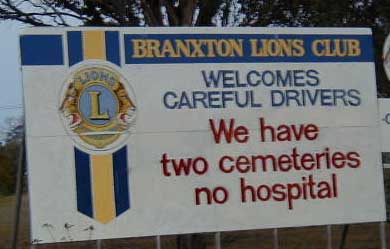Wednesday, Oct 4th: It was finally time to bid
farewell to friends and family in Sydney. The bikes were packed and unnecessary gear was
stored away. We were back to our full compliment of gear, including our tent and cooking
gear that we hadn’t been carrying since India. We’ve learned a lot in the past
500+ days, part of which translated into a lighter load (no longer a duffel-bag of gear on
Erin’s pillion seat), and even a few square inches of unused space in the panniers.
Some of you may not know what I’m getting at: When burning down a sealed highway,
the excess weight on the bike is a non-issue. Well, we haven’t been on the Autobahn
in a long time and less than ideal road conditions and/or hazards have inspired us to try
and "lighten up".
In situations where we’ve had to maneuver the bikes (especially off-road), the
bikes were very heavy and difficult to control – Erin’s bike weighed about
530lbs/240kilos, and mine was around 695lbs/315kilos. The point is we’ve managed to
drop the weight a bit and that should help.
| So, we arrived at Sam and Kav’s place in Newcastle, only 167kms north
of Sydney, but the official start of the Australian leg. Newcastle is a small city
with wonderful beaches, windswept cliffs, and a huge coal-exporting harbor. The town
center is very quaint, with young "uni" students around and graceful old
buildings. |
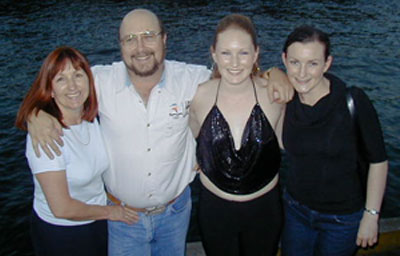 Kav, Sam, Adel,
and Lisa |
Sam rides the same bike I do, and grew up on Long Island,
just a few towns from our house. A geologist by education (in the states), he somehow got
into the coal business, and eventually ended up in Australia (15 years ago). Kav works in
the local school district, and met Sam through a mutual friend. Their first date was a
ride out to the country for a rally on Sam’s bike. As they were cruising along with
other friends, the asphalt gave way to gravel and a few kilometers later a big rock set
the bike sliding out of control. Moments later, Sam was under his bike – he looked to
his left and saw Kav face down and spread-eagle on the gravel, about 10 meters away. She
was pretty banged up, but the full-face helmet saved her from more serious injuries. As
this was "out in the bush", with no ambulance service, Kav climbed back on the
bike, and they rode to the nearest town hospital. Aside from bumps and bruises, they were
both OK, and Kav has been riding pillion ever since ;-)
On Saturday (Oct 7): We went to visit a coal mine Sam used
to work at – There’s only one way to describe this operation: HUGE. Millions to
billions of dollars are spent on these operations, and efficiency is key. Jeff Lamb was
one of the supervisors on this shift, and would be our "tour guide". We loaded
into the 4x4, and rode out on the gravel road about 8kms. The place was HUGE, and Jeff and
Sam said this was actually a small operation.
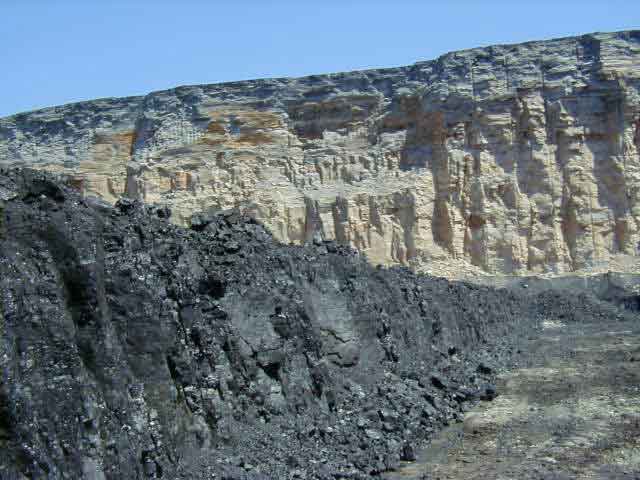 The earth (overburden) has been cleared away, exposing a
black layer of coal or "gold". |
Decomposed trees and vegetation buried below the
earth’s surface form coal. To get at the coal (referred to as "gold"),
soil, sandstone, and rock must be stripped away – Imagine a layer cake with jam
filling, and add a topping of chocolate. Now, flip the cake upside down, start eating from
the top, and eat one layer at a time, until you get to the best part, the dark chocolate
at the bottom – that’s strip mining. Underground mining occurs when the coal
layers are much deeper (I think greater than 100 meters), and it’s more
cost-efficient to build underground tunnels.
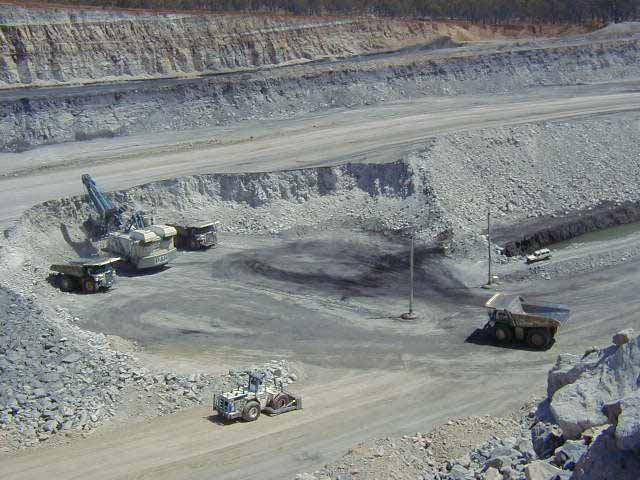 Working to clear the overburden away --
there's a 4meter high seam of coal that can be seen all the way on the right. This
picture is taken atop a relocated pile of overburden. |
Ok, as time = money, the mines job is to get the coal out of
the ground quickly. To do this, you need to clear the levels of over-burden (rock/gravel)
efficiently. So, the formula used is 3 loads from the shovel per dump truck. The bigger
the shovel, the bigger the dump truck. The shovel we saw (really big crane) can scoop up
about 80 tons of over-burden in a shot, requiring trucks capable of hauling 240 tons
(yeow!) per load. Did I mention these trucks are HUGE, and very expensive! The tires are
about 3 meters (10’) high, inflated to 110psi, last for 5,500 hours (just under a
year) and cost about US$20,000 each (enough rubber in each tire to make 400 auto tires).
There are bulldozers and road graters whose only job is to clear the rubble off the road,
to prevent punctures on the dump trucks. All the equipment is hooked up to GPS tracking,
so supervisors can locate any piece of equipment on their computer, and redirect assets as
required.
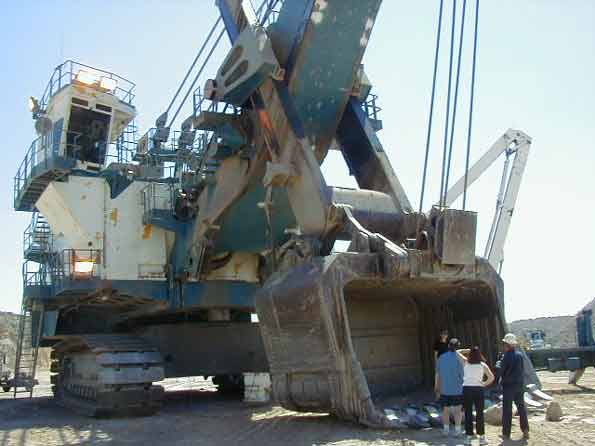 The shovel alone is worth over a million
dollars |
The highlight of the tour was we each got a ride in the
truck. I climbed up, and jumped into the spare seat. We drove about ½ a kilometer to the
shovel then backed up into position. The first load (80 tons) fell into the rear, and the
entire truck lowered with a whoosh. After the third load, a horn blew and we pulled away,
the shovel turned to load a truck on the other side, and yet another truck took our place
as soon as we cleared the area (efficiency). We drove up the hill at a blazing 25km/h and
dumped our load over the edge, refilling a previous dig site. An optimal yield at a mine
is about 5 loads of overburden to one load of coal. This mine was averaging 8 to 1, and
will generate about AUS$100 million/yr. in profit. A mine will generally be profitable for
about 20 years. At the end, the Mine Company is responsible to re-sculpture the ground,
planting grass and trees, and making the area look "untouched".
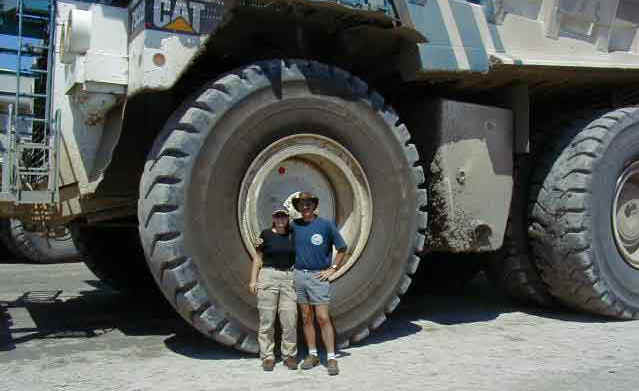 HUGE !! |
Sunday we woke late, and took a ride to the nearby Hunter
Valley – famous for its wonderful vineyards (and wine tasting). We had a terrific
lunch on a terrace overlooking a vineyard – a very relaxing day indeed. Monday
morning we bid Sam & Kav farewell and headed over to John Brison BMW in Newcastle.
Neale and Kay were extremely helpful, and provided an excellent suggestion for our route
NW.
Food for thought, just
out of Newcastle....
